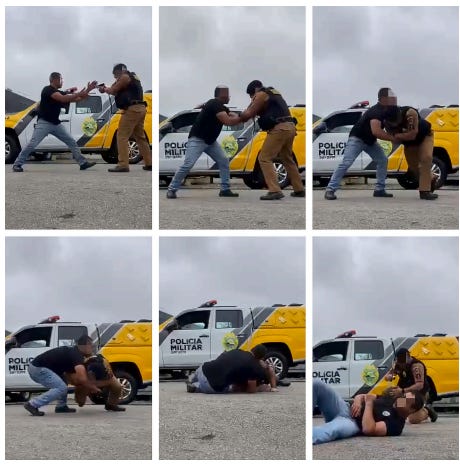Pull Guard to Keep Your Gun?
Publication
Eleuterio, J., Freire, F.D., & Strapasson, B.A. (2024). In-hand handgun retention: A crossover RCE comparing two techniques. Journal of Criminal Justice, 93, 102220.
What Was the Issue?
This study was conducted in Brazil and looked at the ability of officers to retain their handguns using two different techniques. It is important to note that, in Brazil, a suspect trying to grab an officer’s gun is not generally considered a deadly force situation. Brazilian officers also generally work as teams. So their retention tactics focus on the officer whose gun is being grabbed keeping control of the gun while the second officer assists.
How Did They Look at It?
The study was conducted with 30 police recruits as a part of their basic training. Recruits were taught two different retention techniques. The first involved the officer turning into the suspect to place his body between the suspect and the gun (See Figure 1 below). The second involved the officer sitting and placing his feet on the suspect’s hips (See Figure 2 below). After the training, the participants were randomly assigned to one of two groups. These groups then competed in a number of sparring sessions. Each sparring round lasted 30 seconds. During these sessions, the groups were assigned to use one of the two techniques to keep control of their gun while an attacker tried to get it away. A crossover design where each group used both techniques in different sessions was employed. There were also two phases to these sessions. In the first phase, the suspect only attempted to get the gun away from the officer. The session was coded as a failure if the suspect got control of the officer’s firearm. In the second phase, the suspect still attempted to get the firearm away from the officer, but also could hit or submit officer. These sessions were coded as failures for the officers if the suspect got the gun away, submitted the officer, or hit him on the chin, temple, of back of the neck (because hits in these areas could knock the officer out).
Figure 1. The first retention technique.
Figure 2. The second retention technique.
What Did They Find?
Overall, both techniques were about equal in the phase 1 tests. Officers retained their weapons more than 90% of the time during this phase using either technique. There was a difference in success during the phase 2 tests. Officers succeeded about 79% of the time when using the first technique and about 86% of the time using the second. The data structure of this study was quite complex. Each officer used both techniques and participated in multiple sparring rounds across two phases resulting in about 1000 coded rounds. To statistically parse out the effects, complex multilevel modeling was used. This modeling confirmed that the differences observed in the raw numbers reported above were not likely a product of chance (the differences were statistically significant). The researchers also examined a number of other factors that may have contributed to success. Interestingly, they did not find that odds of success got better across the course of the study.
So What?
These tests show that the second technique (which is kind of like a guard pull) was more successful for keeping control of the handgun. The authors believe that this is because the second technique was biomechanically less difficult to preform and it allowed the officer to keep more distance from the suspect - making it more difficult for the suspect to strike the officer in the head. I would add that the second technique also allowed the officer to get the most powerful part of their body (their legs) involved to push against the suspect.
The authors argue that their failure to find an increase in success rates across the course of the study suggests that practice did not improve participant performance. That is possible, but my read of the study is that for most of the sparring rounds, other officers were playing the role of the attacker. It’s possible that officers were learning both how to better retain their weapons and how to better take a gun away during the study and that is why it did not appear that they were improving.
Overall this is an interesting study that provides evidence suggesting that the second technique works better than the first. If I was going to teach a single gun retention technique to officers in the Brazilian context, I would teach the second one. It is really nice to see research add some data to inform arguments about technique.




Good study with small sample.
This is really a tactical backfall weapon retention tactic we’ve taught for over 30 years. Both used for pistol and rifles.
Allows for safer shot trajectory/retention as the rounds move upwards, mitigating the likelihood of hitting other officers/innocents.
https://youtu.be/0Wo6kAmoHEI?si=hFl7hoqhf16A8w3X
Interesting techniques but both have you ending up on the ground, which is a less desirable position to fight from. I have been a follower of Idan Abolnik’s Kalah Combat System. Abolnik is a former Israeli SF and teaches a simple arm control technique for defense against gun and knife attacks that provides an opportunity to fight back and survive the attack.
I think you will find his training video on “How to protect your own gun” of interest https://www.youtube.com/watch?v=Ma9qFEVJdms . Part 2 on protecting an extended gun from a takeaway seems to be a superior technique as it keeps you off the ground and ready to respond. The rationale for the technique and the methods demonstrated can be easily learned by any combative student in the dojo or gym. Train like your life depends on it…because it does.